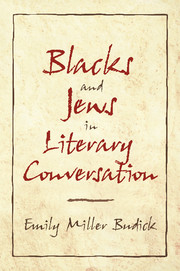Book contents
- Frontmatter
- Contents
- Acknowledgments
- Introduction: “Because you were strangers in the land”
- 1 Mutual Textual Constructions of Black–Jewish Identity
- 2 Crisis and Commentary in African–Jewish American Relations
- 3 Race, Homeland, and the Construction of Jewish American Identity
- 4 Cultural Autonomy, Supersessionism, and the Jew in African American Fiction
- 5 “The Anguish of the Other”: On the Mutual Displacements, Appropriations, and Accommodations of Culture (Toni Morrison, Cynthia Ozick, William Styron, Philip Roth, Grace Paley, and the Jewish–American–Israeli Critic)
- Notes
- Index
1 - Mutual Textual Constructions of Black–Jewish Identity
Published online by Cambridge University Press: 06 July 2010
- Frontmatter
- Contents
- Acknowledgments
- Introduction: “Because you were strangers in the land”
- 1 Mutual Textual Constructions of Black–Jewish Identity
- 2 Crisis and Commentary in African–Jewish American Relations
- 3 Race, Homeland, and the Construction of Jewish American Identity
- 4 Cultural Autonomy, Supersessionism, and the Jew in African American Fiction
- 5 “The Anguish of the Other”: On the Mutual Displacements, Appropriations, and Accommodations of Culture (Toni Morrison, Cynthia Ozick, William Styron, Philip Roth, Grace Paley, and the Jewish–American–Israeli Critic)
- Notes
- Index
Summary
If we blow into the narrow end of the shofar, we will be heard far. But if we choose to be Mankind rather than Jewish and blow into the wider part, we will not be heard at all; for us, America will have been in vain.
Cynthia Ozick, “Toward a New Yiddish”The story of the Negro in America is the story of America … Our dehumanization of the Negro … is indivisible from our dehumanization of ourselves: the loss of our own identity is the price we pay for our annulment of his.
James Baldwin, “Many Thousands Gone”According to an extraordinarily lengthy series of books, collections, articles, and symposia published in the late 1960s and early 1970s, the 1960s witnessed a baffling and painful demise of what many intellectuals of the period referred to as the “Negro–Jewish alliance.” This lament for the end of the black–Jewish alliance is odd, for at least two reasons. First of all, by most responsible accounts, the alliance hardly existed before the Civil Rights activism of the 1950s. This is not in any way to deny the significant intervention of certain prominent Jews in the NAACP and other black organizations. Nor is it to erase black–Jewish involvement in the Communist Party or the labor unions. It is, however, to suggest that the term “alliance” misstates or overstates the nature of the exchange.
- Type
- Chapter
- Information
- Blacks and Jews in Literary Conversation , pp. 9 - 60Publisher: Cambridge University PressPrint publication year: 1998

